Personal Leadership Style: Development for Effective Leadership
VerifiedAdded on 2020/05/16
|10
|2708
|29
Essay
AI Summary
This essay delves into the intricacies of personal leadership styles, aiming to identify strengths and weaknesses for effective leadership. The author conducts a self-assessment, utilizing the Johari Window to gain insights into their leadership attributes and areas for improvement. The essay contrasts autocratic leadership with democratic and transformational styles, advocating for a blend of the latter two. It highlights the importance of inspirational motivation, intellectual stimulation, and individualized consideration. The influence of globalization and multiculturalism on leadership is also discussed, with an emphasis on the need for cultural competency and bias-free approaches. The author draws inspiration from Richard Branson's leadership style and outlines strategies for fostering open communication, team building, and motivation to create a competitive and enthusiastic working environment. The conclusion emphasizes the importance of adapting leadership styles to empower teams and achieve organizational goals.
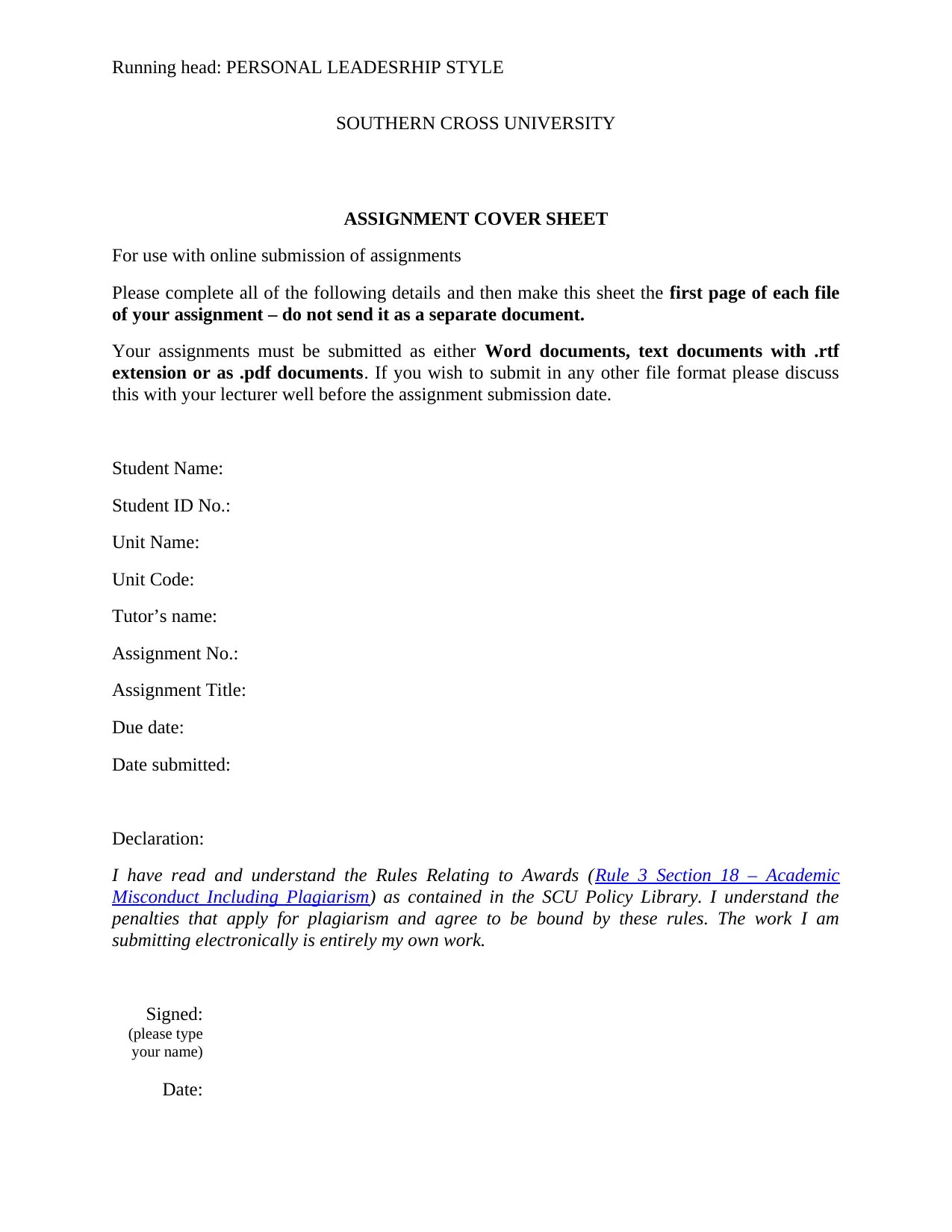
Running head: PERSONAL LEADESRHIP STYLE
SOUTHERN CROSS UNIVERSITY
ASSIGNMENT COVER SHEET
For use with online submission of assignments
Please complete all of the following details and then make this sheet the first page of each file
of your assignment – do not send it as a separate document.
Your assignments must be submitted as either Word documents, text documents with .rtf
extension or as .pdf documents. If you wish to submit in any other file format please discuss
this with your lecturer well before the assignment submission date.
Student Name:
Student ID No.:
Unit Name:
Unit Code:
Tutor’s name:
Assignment No.:
Assignment Title:
Due date:
Date submitted:
Declaration:
I have read and understand the Rules Relating to Awards (Rule 3 Section 18 – Academic
Misconduct Including Plagiarism) as contained in the SCU Policy Library. I understand the
penalties that apply for plagiarism and agree to be bound by these rules. The work I am
submitting electronically is entirely my own work.
Signed:
(please type
your name)
Date:
SOUTHERN CROSS UNIVERSITY
ASSIGNMENT COVER SHEET
For use with online submission of assignments
Please complete all of the following details and then make this sheet the first page of each file
of your assignment – do not send it as a separate document.
Your assignments must be submitted as either Word documents, text documents with .rtf
extension or as .pdf documents. If you wish to submit in any other file format please discuss
this with your lecturer well before the assignment submission date.
Student Name:
Student ID No.:
Unit Name:
Unit Code:
Tutor’s name:
Assignment No.:
Assignment Title:
Due date:
Date submitted:
Declaration:
I have read and understand the Rules Relating to Awards (Rule 3 Section 18 – Academic
Misconduct Including Plagiarism) as contained in the SCU Policy Library. I understand the
penalties that apply for plagiarism and agree to be bound by these rules. The work I am
submitting electronically is entirely my own work.
Signed:
(please type
your name)
Date:
Paraphrase This Document
Need a fresh take? Get an instant paraphrase of this document with our AI Paraphraser
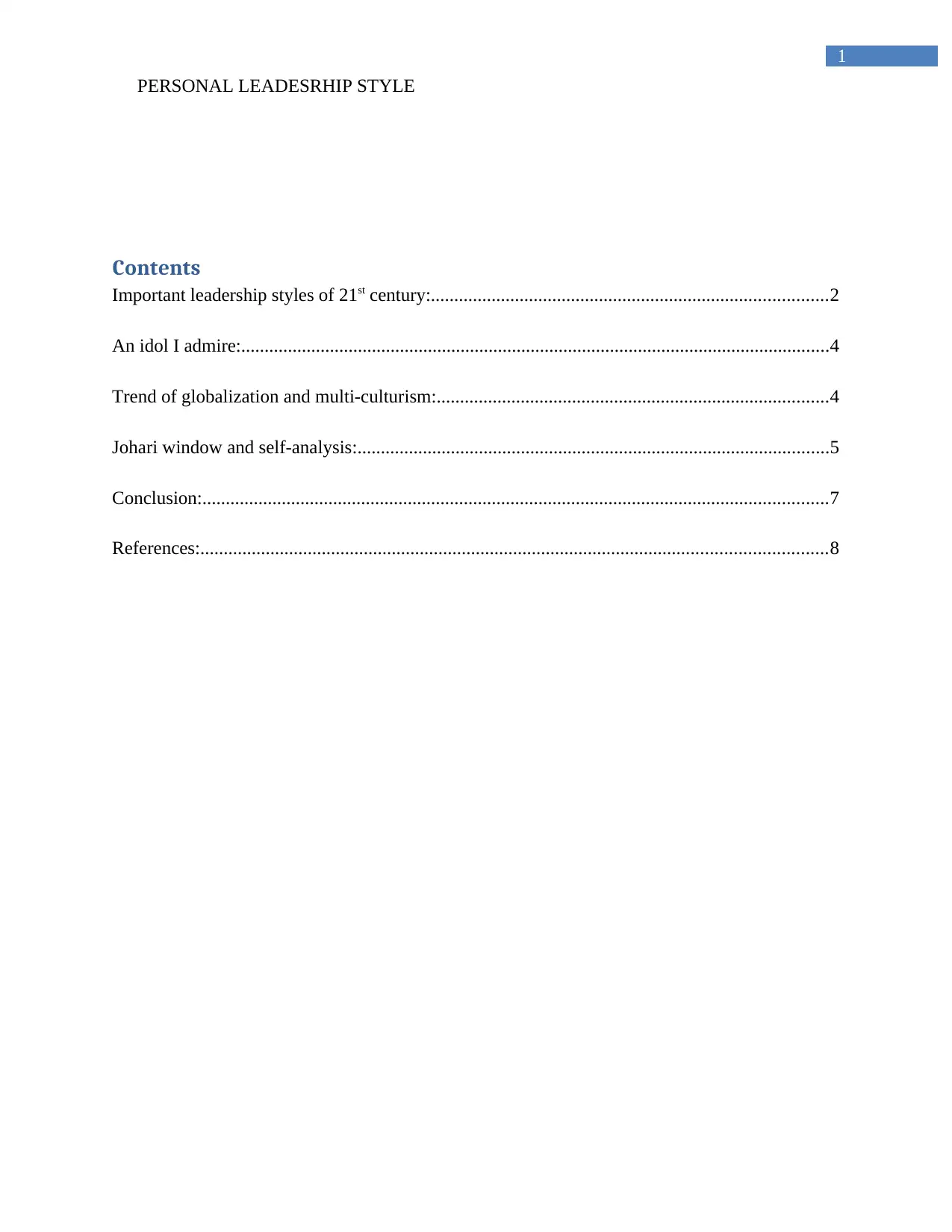
1
PERSONAL LEADESRHIP STYLE
Contents
Important leadership styles of 21st century:.....................................................................................2
An idol I admire:..............................................................................................................................4
Trend of globalization and multi-culturism:....................................................................................4
Johari window and self-analysis:.....................................................................................................5
Conclusion:......................................................................................................................................7
References:......................................................................................................................................8
PERSONAL LEADESRHIP STYLE
Contents
Important leadership styles of 21st century:.....................................................................................2
An idol I admire:..............................................................................................................................4
Trend of globalization and multi-culturism:....................................................................................4
Johari window and self-analysis:.....................................................................................................5
Conclusion:......................................................................................................................................7
References:......................................................................................................................................8
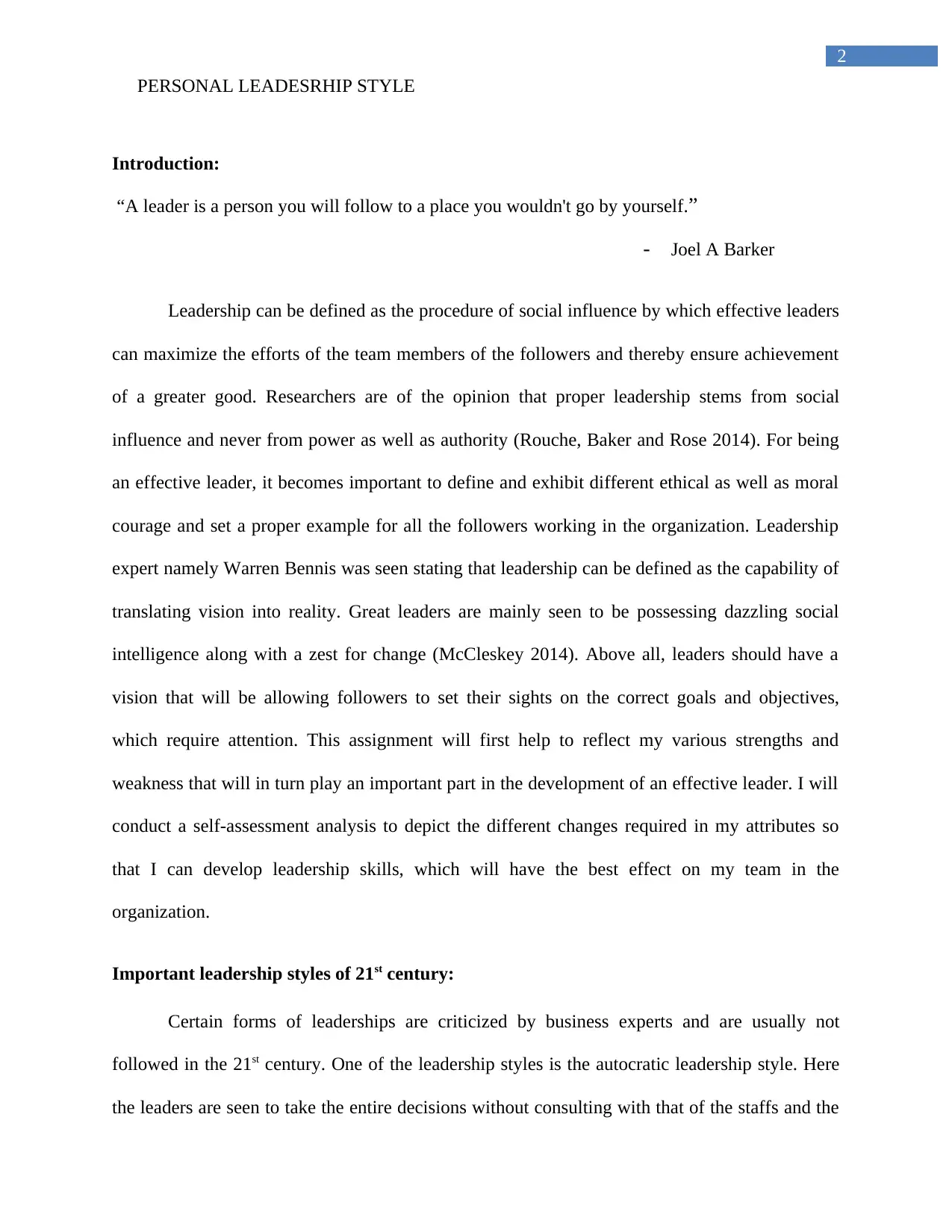
2
PERSONAL LEADESRHIP STYLE
Introduction:
“A leader is a person you will follow to a place you wouldn't go by yourself.”
- Joel A Barker
Leadership can be defined as the procedure of social influence by which effective leaders
can maximize the efforts of the team members of the followers and thereby ensure achievement
of a greater good. Researchers are of the opinion that proper leadership stems from social
influence and never from power as well as authority (Rouche, Baker and Rose 2014). For being
an effective leader, it becomes important to define and exhibit different ethical as well as moral
courage and set a proper example for all the followers working in the organization. Leadership
expert namely Warren Bennis was seen stating that leadership can be defined as the capability of
translating vision into reality. Great leaders are mainly seen to be possessing dazzling social
intelligence along with a zest for change (McCleskey 2014). Above all, leaders should have a
vision that will be allowing followers to set their sights on the correct goals and objectives,
which require attention. This assignment will first help to reflect my various strengths and
weakness that will in turn play an important part in the development of an effective leader. I will
conduct a self-assessment analysis to depict the different changes required in my attributes so
that I can develop leadership skills, which will have the best effect on my team in the
organization.
Important leadership styles of 21st century:
Certain forms of leaderships are criticized by business experts and are usually not
followed in the 21st century. One of the leadership styles is the autocratic leadership style. Here
the leaders are seen to take the entire decisions without consulting with that of the staffs and the
PERSONAL LEADESRHIP STYLE
Introduction:
“A leader is a person you will follow to a place you wouldn't go by yourself.”
- Joel A Barker
Leadership can be defined as the procedure of social influence by which effective leaders
can maximize the efforts of the team members of the followers and thereby ensure achievement
of a greater good. Researchers are of the opinion that proper leadership stems from social
influence and never from power as well as authority (Rouche, Baker and Rose 2014). For being
an effective leader, it becomes important to define and exhibit different ethical as well as moral
courage and set a proper example for all the followers working in the organization. Leadership
expert namely Warren Bennis was seen stating that leadership can be defined as the capability of
translating vision into reality. Great leaders are mainly seen to be possessing dazzling social
intelligence along with a zest for change (McCleskey 2014). Above all, leaders should have a
vision that will be allowing followers to set their sights on the correct goals and objectives,
which require attention. This assignment will first help to reflect my various strengths and
weakness that will in turn play an important part in the development of an effective leader. I will
conduct a self-assessment analysis to depict the different changes required in my attributes so
that I can develop leadership skills, which will have the best effect on my team in the
organization.
Important leadership styles of 21st century:
Certain forms of leaderships are criticized by business experts and are usually not
followed in the 21st century. One of the leadership styles is the autocratic leadership style. Here
the leaders are seen to take the entire decisions without consulting with that of the staffs and the
⊘ This is a preview!⊘
Do you want full access?
Subscribe today to unlock all pages.

Trusted by 1+ million students worldwide
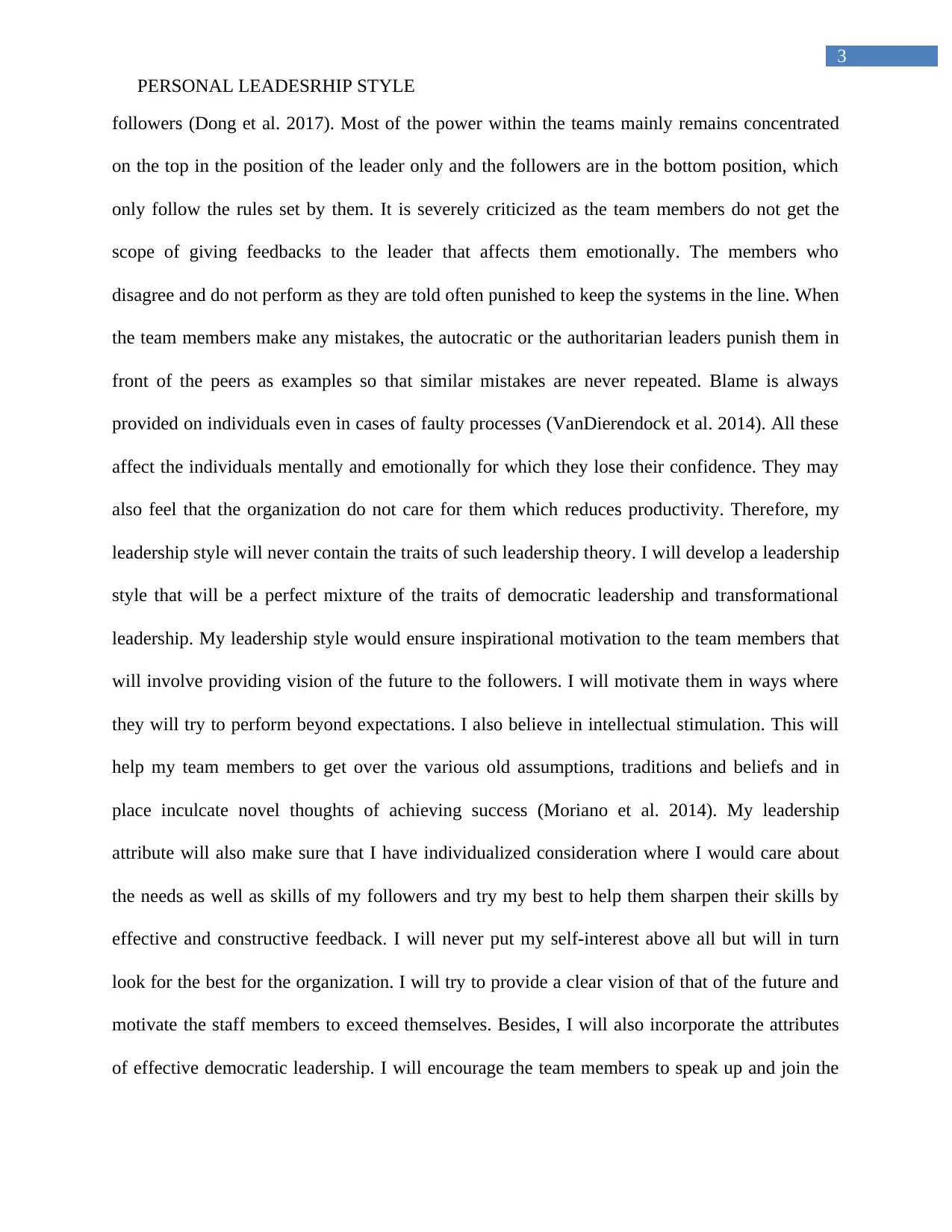
3
PERSONAL LEADESRHIP STYLE
followers (Dong et al. 2017). Most of the power within the teams mainly remains concentrated
on the top in the position of the leader only and the followers are in the bottom position, which
only follow the rules set by them. It is severely criticized as the team members do not get the
scope of giving feedbacks to the leader that affects them emotionally. The members who
disagree and do not perform as they are told often punished to keep the systems in the line. When
the team members make any mistakes, the autocratic or the authoritarian leaders punish them in
front of the peers as examples so that similar mistakes are never repeated. Blame is always
provided on individuals even in cases of faulty processes (VanDierendock et al. 2014). All these
affect the individuals mentally and emotionally for which they lose their confidence. They may
also feel that the organization do not care for them which reduces productivity. Therefore, my
leadership style will never contain the traits of such leadership theory. I will develop a leadership
style that will be a perfect mixture of the traits of democratic leadership and transformational
leadership. My leadership style would ensure inspirational motivation to the team members that
will involve providing vision of the future to the followers. I will motivate them in ways where
they will try to perform beyond expectations. I also believe in intellectual stimulation. This will
help my team members to get over the various old assumptions, traditions and beliefs and in
place inculcate novel thoughts of achieving success (Moriano et al. 2014). My leadership
attribute will also make sure that I have individualized consideration where I would care about
the needs as well as skills of my followers and try my best to help them sharpen their skills by
effective and constructive feedback. I will never put my self-interest above all but will in turn
look for the best for the organization. I will try to provide a clear vision of that of the future and
motivate the staff members to exceed themselves. Besides, I will also incorporate the attributes
of effective democratic leadership. I will encourage the team members to speak up and join the
PERSONAL LEADESRHIP STYLE
followers (Dong et al. 2017). Most of the power within the teams mainly remains concentrated
on the top in the position of the leader only and the followers are in the bottom position, which
only follow the rules set by them. It is severely criticized as the team members do not get the
scope of giving feedbacks to the leader that affects them emotionally. The members who
disagree and do not perform as they are told often punished to keep the systems in the line. When
the team members make any mistakes, the autocratic or the authoritarian leaders punish them in
front of the peers as examples so that similar mistakes are never repeated. Blame is always
provided on individuals even in cases of faulty processes (VanDierendock et al. 2014). All these
affect the individuals mentally and emotionally for which they lose their confidence. They may
also feel that the organization do not care for them which reduces productivity. Therefore, my
leadership style will never contain the traits of such leadership theory. I will develop a leadership
style that will be a perfect mixture of the traits of democratic leadership and transformational
leadership. My leadership style would ensure inspirational motivation to the team members that
will involve providing vision of the future to the followers. I will motivate them in ways where
they will try to perform beyond expectations. I also believe in intellectual stimulation. This will
help my team members to get over the various old assumptions, traditions and beliefs and in
place inculcate novel thoughts of achieving success (Moriano et al. 2014). My leadership
attribute will also make sure that I have individualized consideration where I would care about
the needs as well as skills of my followers and try my best to help them sharpen their skills by
effective and constructive feedback. I will never put my self-interest above all but will in turn
look for the best for the organization. I will try to provide a clear vision of that of the future and
motivate the staff members to exceed themselves. Besides, I will also incorporate the attributes
of effective democratic leadership. I will encourage the team members to speak up and join the
Paraphrase This Document
Need a fresh take? Get an instant paraphrase of this document with our AI Paraphraser
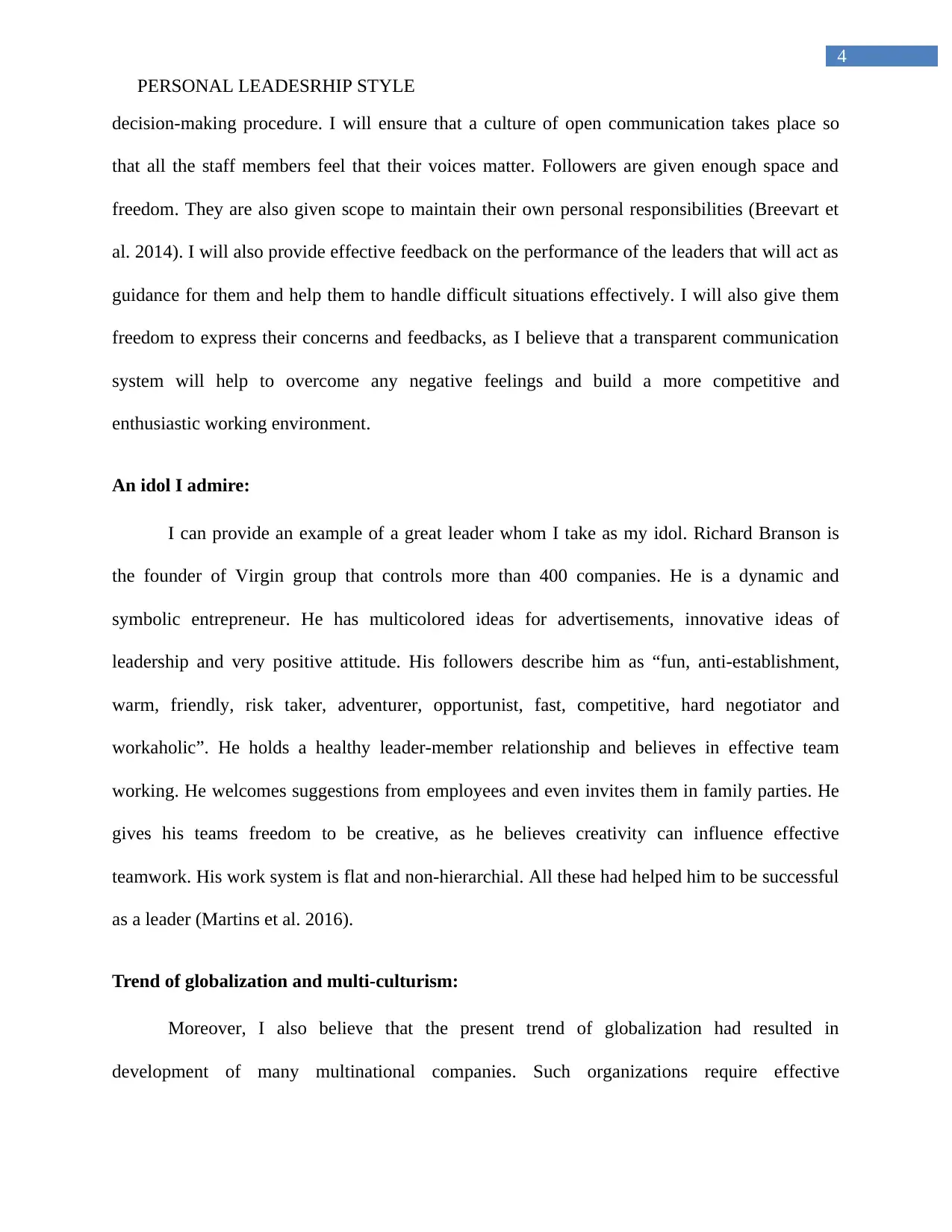
4
PERSONAL LEADESRHIP STYLE
decision-making procedure. I will ensure that a culture of open communication takes place so
that all the staff members feel that their voices matter. Followers are given enough space and
freedom. They are also given scope to maintain their own personal responsibilities (Breevart et
al. 2014). I will also provide effective feedback on the performance of the leaders that will act as
guidance for them and help them to handle difficult situations effectively. I will also give them
freedom to express their concerns and feedbacks, as I believe that a transparent communication
system will help to overcome any negative feelings and build a more competitive and
enthusiastic working environment.
An idol I admire:
I can provide an example of a great leader whom I take as my idol. Richard Branson is
the founder of Virgin group that controls more than 400 companies. He is a dynamic and
symbolic entrepreneur. He has multicolored ideas for advertisements, innovative ideas of
leadership and very positive attitude. His followers describe him as “fun, anti-establishment,
warm, friendly, risk taker, adventurer, opportunist, fast, competitive, hard negotiator and
workaholic”. He holds a healthy leader-member relationship and believes in effective team
working. He welcomes suggestions from employees and even invites them in family parties. He
gives his teams freedom to be creative, as he believes creativity can influence effective
teamwork. His work system is flat and non-hierarchial. All these had helped him to be successful
as a leader (Martins et al. 2016).
Trend of globalization and multi-culturism:
Moreover, I also believe that the present trend of globalization had resulted in
development of many multinational companies. Such organizations require effective
PERSONAL LEADESRHIP STYLE
decision-making procedure. I will ensure that a culture of open communication takes place so
that all the staff members feel that their voices matter. Followers are given enough space and
freedom. They are also given scope to maintain their own personal responsibilities (Breevart et
al. 2014). I will also provide effective feedback on the performance of the leaders that will act as
guidance for them and help them to handle difficult situations effectively. I will also give them
freedom to express their concerns and feedbacks, as I believe that a transparent communication
system will help to overcome any negative feelings and build a more competitive and
enthusiastic working environment.
An idol I admire:
I can provide an example of a great leader whom I take as my idol. Richard Branson is
the founder of Virgin group that controls more than 400 companies. He is a dynamic and
symbolic entrepreneur. He has multicolored ideas for advertisements, innovative ideas of
leadership and very positive attitude. His followers describe him as “fun, anti-establishment,
warm, friendly, risk taker, adventurer, opportunist, fast, competitive, hard negotiator and
workaholic”. He holds a healthy leader-member relationship and believes in effective team
working. He welcomes suggestions from employees and even invites them in family parties. He
gives his teams freedom to be creative, as he believes creativity can influence effective
teamwork. His work system is flat and non-hierarchial. All these had helped him to be successful
as a leader (Martins et al. 2016).
Trend of globalization and multi-culturism:
Moreover, I also believe that the present trend of globalization had resulted in
development of many multinational companies. Such organizations require effective
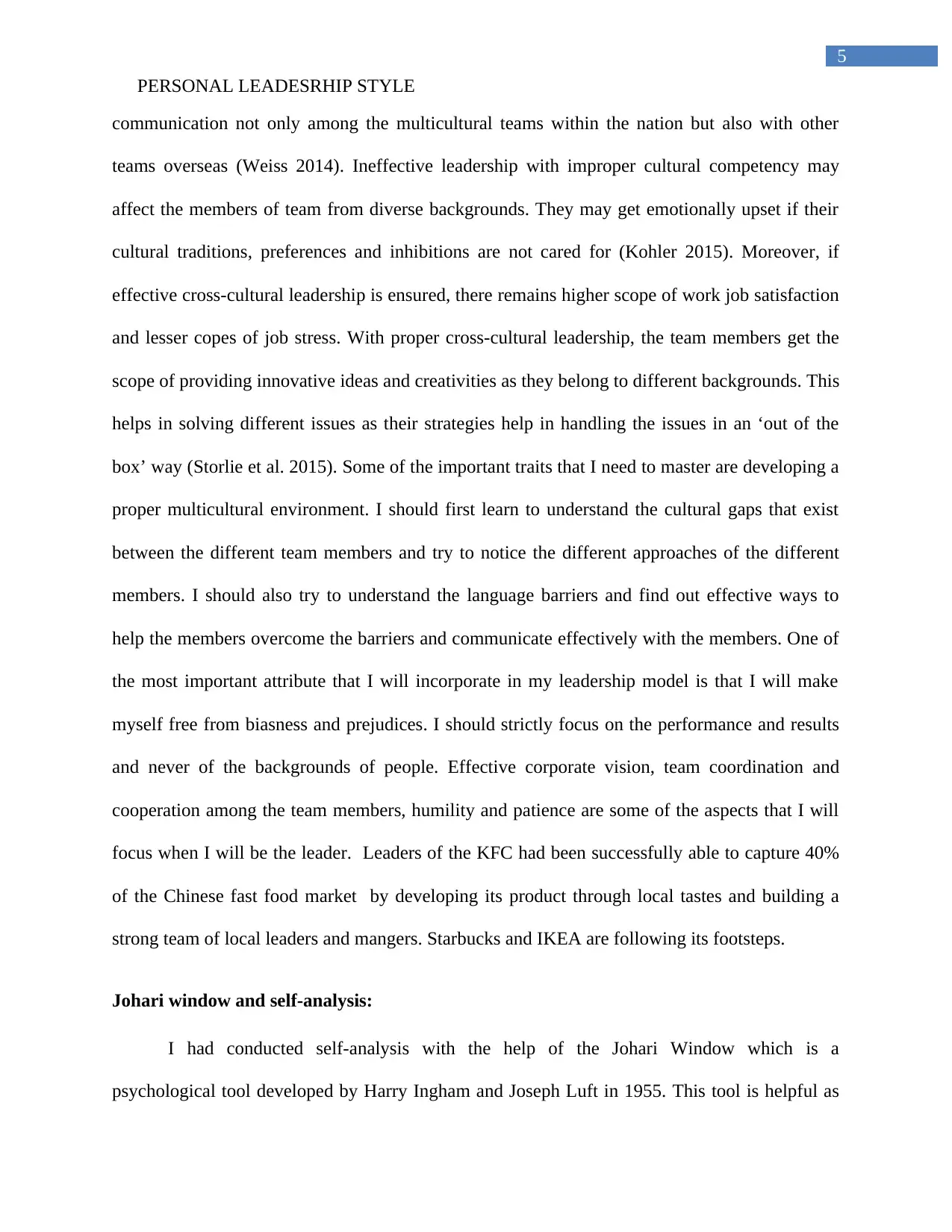
5
PERSONAL LEADESRHIP STYLE
communication not only among the multicultural teams within the nation but also with other
teams overseas (Weiss 2014). Ineffective leadership with improper cultural competency may
affect the members of team from diverse backgrounds. They may get emotionally upset if their
cultural traditions, preferences and inhibitions are not cared for (Kohler 2015). Moreover, if
effective cross-cultural leadership is ensured, there remains higher scope of work job satisfaction
and lesser copes of job stress. With proper cross-cultural leadership, the team members get the
scope of providing innovative ideas and creativities as they belong to different backgrounds. This
helps in solving different issues as their strategies help in handling the issues in an ‘out of the
box’ way (Storlie et al. 2015). Some of the important traits that I need to master are developing a
proper multicultural environment. I should first learn to understand the cultural gaps that exist
between the different team members and try to notice the different approaches of the different
members. I should also try to understand the language barriers and find out effective ways to
help the members overcome the barriers and communicate effectively with the members. One of
the most important attribute that I will incorporate in my leadership model is that I will make
myself free from biasness and prejudices. I should strictly focus on the performance and results
and never of the backgrounds of people. Effective corporate vision, team coordination and
cooperation among the team members, humility and patience are some of the aspects that I will
focus when I will be the leader. Leaders of the KFC had been successfully able to capture 40%
of the Chinese fast food market by developing its product through local tastes and building a
strong team of local leaders and mangers. Starbucks and IKEA are following its footsteps.
Johari window and self-analysis:
I had conducted self-analysis with the help of the Johari Window which is a
psychological tool developed by Harry Ingham and Joseph Luft in 1955. This tool is helpful as
PERSONAL LEADESRHIP STYLE
communication not only among the multicultural teams within the nation but also with other
teams overseas (Weiss 2014). Ineffective leadership with improper cultural competency may
affect the members of team from diverse backgrounds. They may get emotionally upset if their
cultural traditions, preferences and inhibitions are not cared for (Kohler 2015). Moreover, if
effective cross-cultural leadership is ensured, there remains higher scope of work job satisfaction
and lesser copes of job stress. With proper cross-cultural leadership, the team members get the
scope of providing innovative ideas and creativities as they belong to different backgrounds. This
helps in solving different issues as their strategies help in handling the issues in an ‘out of the
box’ way (Storlie et al. 2015). Some of the important traits that I need to master are developing a
proper multicultural environment. I should first learn to understand the cultural gaps that exist
between the different team members and try to notice the different approaches of the different
members. I should also try to understand the language barriers and find out effective ways to
help the members overcome the barriers and communicate effectively with the members. One of
the most important attribute that I will incorporate in my leadership model is that I will make
myself free from biasness and prejudices. I should strictly focus on the performance and results
and never of the backgrounds of people. Effective corporate vision, team coordination and
cooperation among the team members, humility and patience are some of the aspects that I will
focus when I will be the leader. Leaders of the KFC had been successfully able to capture 40%
of the Chinese fast food market by developing its product through local tastes and building a
strong team of local leaders and mangers. Starbucks and IKEA are following its footsteps.
Johari window and self-analysis:
I had conducted self-analysis with the help of the Johari Window which is a
psychological tool developed by Harry Ingham and Joseph Luft in 1955. This tool is helpful as
⊘ This is a preview!⊘
Do you want full access?
Subscribe today to unlock all pages.

Trusted by 1+ million students worldwide
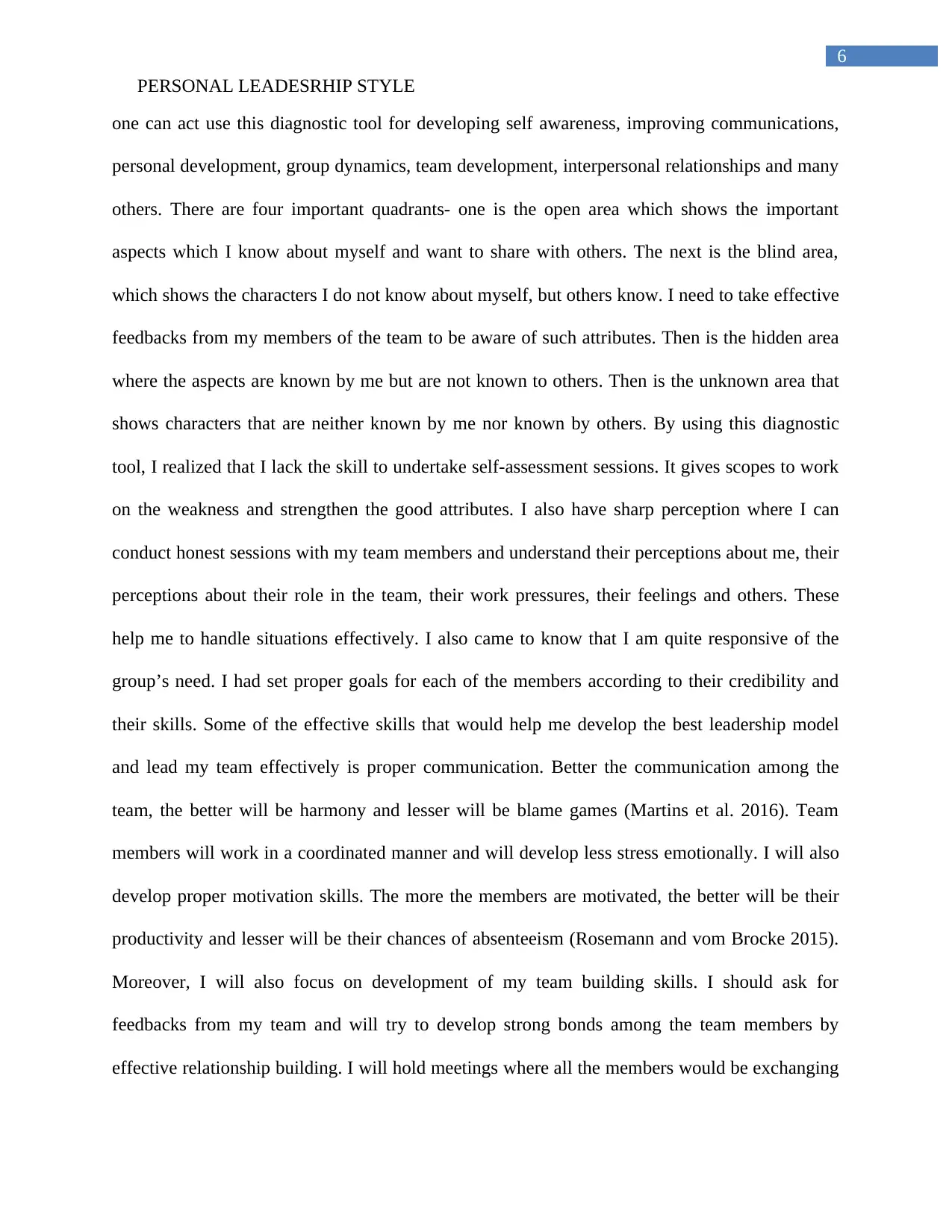
6
PERSONAL LEADESRHIP STYLE
one can act use this diagnostic tool for developing self awareness, improving communications,
personal development, group dynamics, team development, interpersonal relationships and many
others. There are four important quadrants- one is the open area which shows the important
aspects which I know about myself and want to share with others. The next is the blind area,
which shows the characters I do not know about myself, but others know. I need to take effective
feedbacks from my members of the team to be aware of such attributes. Then is the hidden area
where the aspects are known by me but are not known to others. Then is the unknown area that
shows characters that are neither known by me nor known by others. By using this diagnostic
tool, I realized that I lack the skill to undertake self-assessment sessions. It gives scopes to work
on the weakness and strengthen the good attributes. I also have sharp perception where I can
conduct honest sessions with my team members and understand their perceptions about me, their
perceptions about their role in the team, their work pressures, their feelings and others. These
help me to handle situations effectively. I also came to know that I am quite responsive of the
group’s need. I had set proper goals for each of the members according to their credibility and
their skills. Some of the effective skills that would help me develop the best leadership model
and lead my team effectively is proper communication. Better the communication among the
team, the better will be harmony and lesser will be blame games (Martins et al. 2016). Team
members will work in a coordinated manner and will develop less stress emotionally. I will also
develop proper motivation skills. The more the members are motivated, the better will be their
productivity and lesser will be their chances of absenteeism (Rosemann and vom Brocke 2015).
Moreover, I will also focus on development of my team building skills. I should ask for
feedbacks from my team and will try to develop strong bonds among the team members by
effective relationship building. I will hold meetings where all the members would be exchanging
PERSONAL LEADESRHIP STYLE
one can act use this diagnostic tool for developing self awareness, improving communications,
personal development, group dynamics, team development, interpersonal relationships and many
others. There are four important quadrants- one is the open area which shows the important
aspects which I know about myself and want to share with others. The next is the blind area,
which shows the characters I do not know about myself, but others know. I need to take effective
feedbacks from my members of the team to be aware of such attributes. Then is the hidden area
where the aspects are known by me but are not known to others. Then is the unknown area that
shows characters that are neither known by me nor known by others. By using this diagnostic
tool, I realized that I lack the skill to undertake self-assessment sessions. It gives scopes to work
on the weakness and strengthen the good attributes. I also have sharp perception where I can
conduct honest sessions with my team members and understand their perceptions about me, their
perceptions about their role in the team, their work pressures, their feelings and others. These
help me to handle situations effectively. I also came to know that I am quite responsive of the
group’s need. I had set proper goals for each of the members according to their credibility and
their skills. Some of the effective skills that would help me develop the best leadership model
and lead my team effectively is proper communication. Better the communication among the
team, the better will be harmony and lesser will be blame games (Martins et al. 2016). Team
members will work in a coordinated manner and will develop less stress emotionally. I will also
develop proper motivation skills. The more the members are motivated, the better will be their
productivity and lesser will be their chances of absenteeism (Rosemann and vom Brocke 2015).
Moreover, I will also focus on development of my team building skills. I should ask for
feedbacks from my team and will try to develop strong bonds among the team members by
effective relationship building. I will hold meetings where all the members would be exchanging
Paraphrase This Document
Need a fresh take? Get an instant paraphrase of this document with our AI Paraphraser
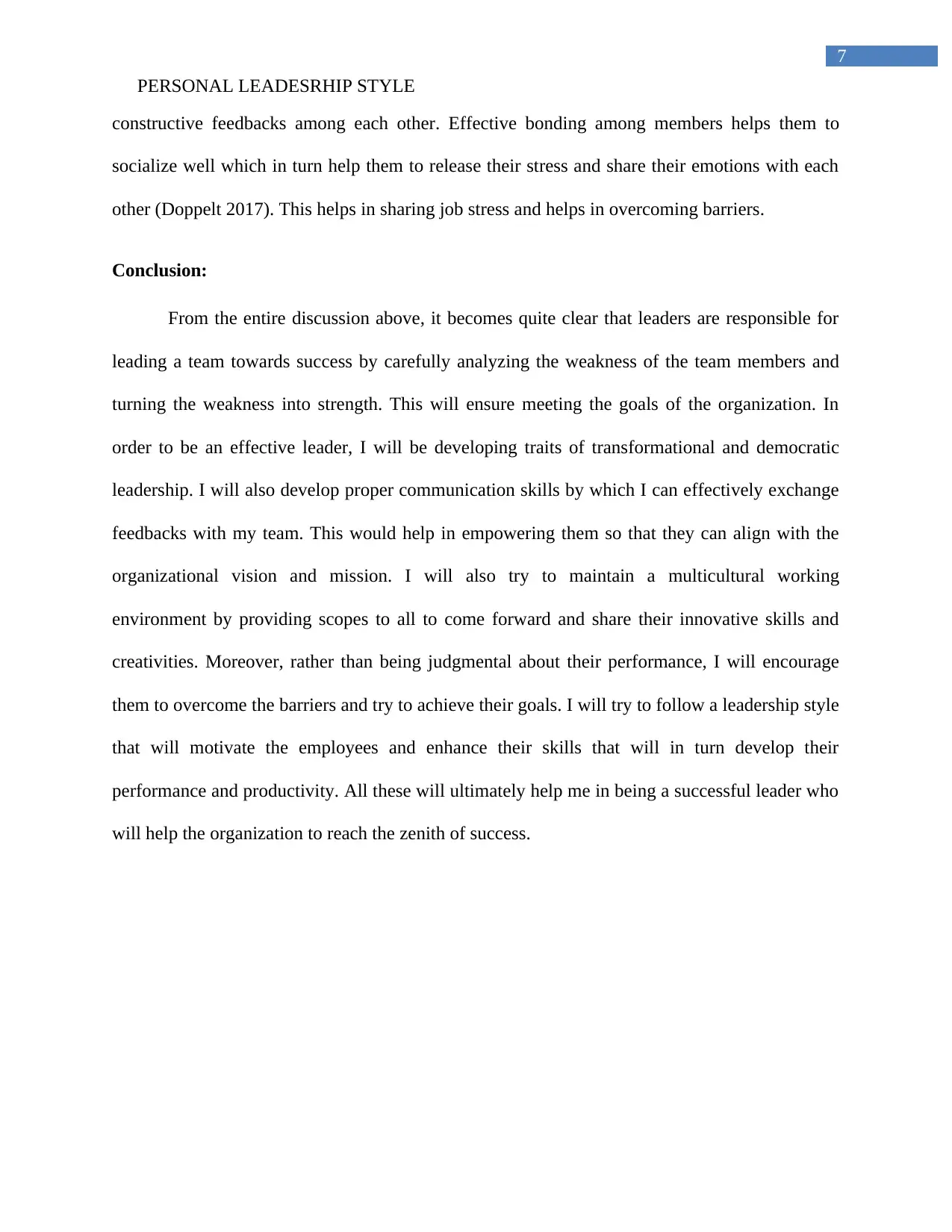
7
PERSONAL LEADESRHIP STYLE
constructive feedbacks among each other. Effective bonding among members helps them to
socialize well which in turn help them to release their stress and share their emotions with each
other (Doppelt 2017). This helps in sharing job stress and helps in overcoming barriers.
Conclusion:
From the entire discussion above, it becomes quite clear that leaders are responsible for
leading a team towards success by carefully analyzing the weakness of the team members and
turning the weakness into strength. This will ensure meeting the goals of the organization. In
order to be an effective leader, I will be developing traits of transformational and democratic
leadership. I will also develop proper communication skills by which I can effectively exchange
feedbacks with my team. This would help in empowering them so that they can align with the
organizational vision and mission. I will also try to maintain a multicultural working
environment by providing scopes to all to come forward and share their innovative skills and
creativities. Moreover, rather than being judgmental about their performance, I will encourage
them to overcome the barriers and try to achieve their goals. I will try to follow a leadership style
that will motivate the employees and enhance their skills that will in turn develop their
performance and productivity. All these will ultimately help me in being a successful leader who
will help the organization to reach the zenith of success.
PERSONAL LEADESRHIP STYLE
constructive feedbacks among each other. Effective bonding among members helps them to
socialize well which in turn help them to release their stress and share their emotions with each
other (Doppelt 2017). This helps in sharing job stress and helps in overcoming barriers.
Conclusion:
From the entire discussion above, it becomes quite clear that leaders are responsible for
leading a team towards success by carefully analyzing the weakness of the team members and
turning the weakness into strength. This will ensure meeting the goals of the organization. In
order to be an effective leader, I will be developing traits of transformational and democratic
leadership. I will also develop proper communication skills by which I can effectively exchange
feedbacks with my team. This would help in empowering them so that they can align with the
organizational vision and mission. I will also try to maintain a multicultural working
environment by providing scopes to all to come forward and share their innovative skills and
creativities. Moreover, rather than being judgmental about their performance, I will encourage
them to overcome the barriers and try to achieve their goals. I will try to follow a leadership style
that will motivate the employees and enhance their skills that will in turn develop their
performance and productivity. All these will ultimately help me in being a successful leader who
will help the organization to reach the zenith of success.
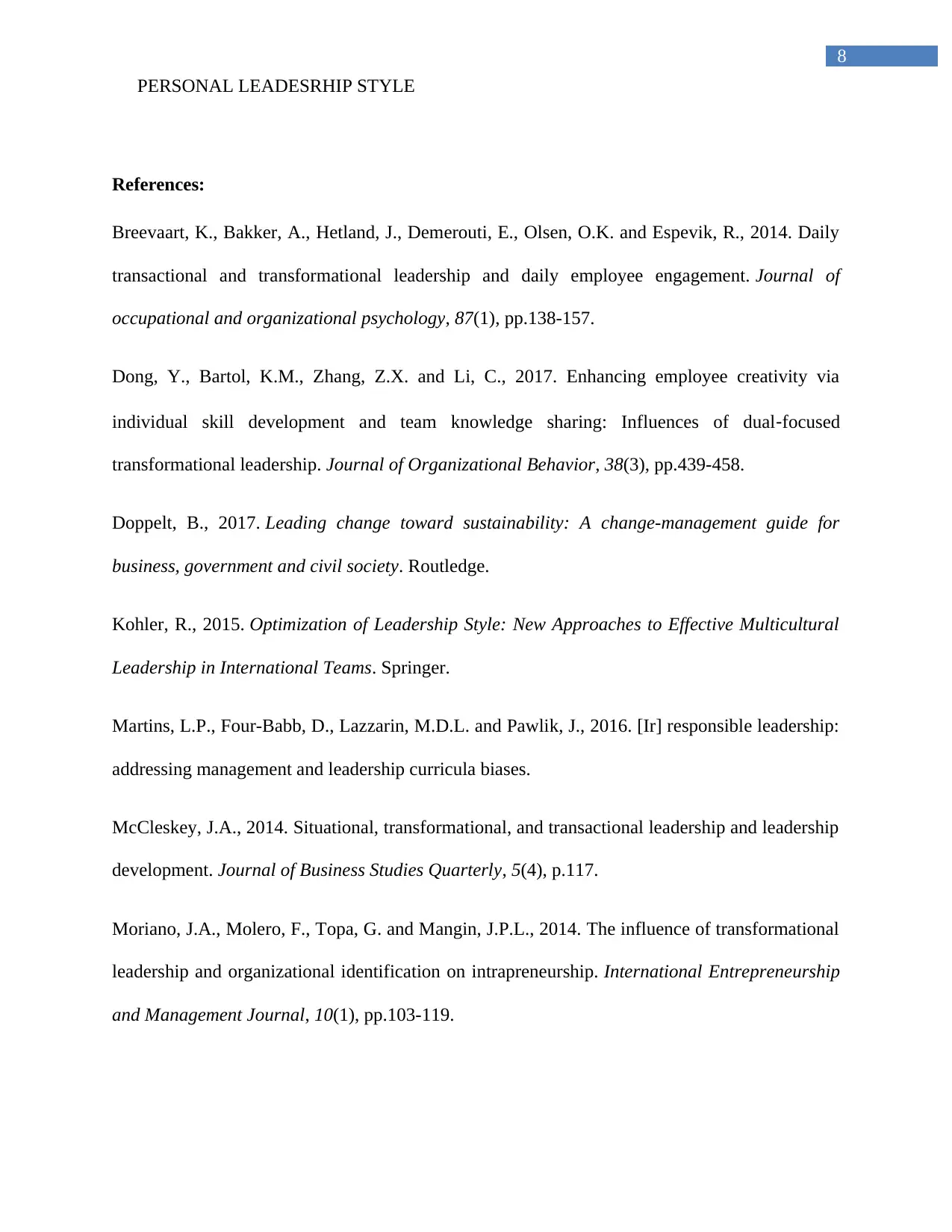
8
PERSONAL LEADESRHIP STYLE
References:
Breevaart, K., Bakker, A., Hetland, J., Demerouti, E., Olsen, O.K. and Espevik, R., 2014. Daily
transactional and transformational leadership and daily employee engagement. Journal of
occupational and organizational psychology, 87(1), pp.138-157.
Dong, Y., Bartol, K.M., Zhang, Z.X. and Li, C., 2017. Enhancing employee creativity via
individual skill development and team knowledge sharing: Influences of dual‐focused
transformational leadership. Journal of Organizational Behavior, 38(3), pp.439-458.
Doppelt, B., 2017. Leading change toward sustainability: A change-management guide for
business, government and civil society. Routledge.
Kohler, R., 2015. Optimization of Leadership Style: New Approaches to Effective Multicultural
Leadership in International Teams. Springer.
Martins, L.P., Four-Babb, D., Lazzarin, M.D.L. and Pawlik, J., 2016. [Ir] responsible leadership:
addressing management and leadership curricula biases.
McCleskey, J.A., 2014. Situational, transformational, and transactional leadership and leadership
development. Journal of Business Studies Quarterly, 5(4), p.117.
Moriano, J.A., Molero, F., Topa, G. and Mangin, J.P.L., 2014. The influence of transformational
leadership and organizational identification on intrapreneurship. International Entrepreneurship
and Management Journal, 10(1), pp.103-119.
PERSONAL LEADESRHIP STYLE
References:
Breevaart, K., Bakker, A., Hetland, J., Demerouti, E., Olsen, O.K. and Espevik, R., 2014. Daily
transactional and transformational leadership and daily employee engagement. Journal of
occupational and organizational psychology, 87(1), pp.138-157.
Dong, Y., Bartol, K.M., Zhang, Z.X. and Li, C., 2017. Enhancing employee creativity via
individual skill development and team knowledge sharing: Influences of dual‐focused
transformational leadership. Journal of Organizational Behavior, 38(3), pp.439-458.
Doppelt, B., 2017. Leading change toward sustainability: A change-management guide for
business, government and civil society. Routledge.
Kohler, R., 2015. Optimization of Leadership Style: New Approaches to Effective Multicultural
Leadership in International Teams. Springer.
Martins, L.P., Four-Babb, D., Lazzarin, M.D.L. and Pawlik, J., 2016. [Ir] responsible leadership:
addressing management and leadership curricula biases.
McCleskey, J.A., 2014. Situational, transformational, and transactional leadership and leadership
development. Journal of Business Studies Quarterly, 5(4), p.117.
Moriano, J.A., Molero, F., Topa, G. and Mangin, J.P.L., 2014. The influence of transformational
leadership and organizational identification on intrapreneurship. International Entrepreneurship
and Management Journal, 10(1), pp.103-119.
⊘ This is a preview!⊘
Do you want full access?
Subscribe today to unlock all pages.

Trusted by 1+ million students worldwide
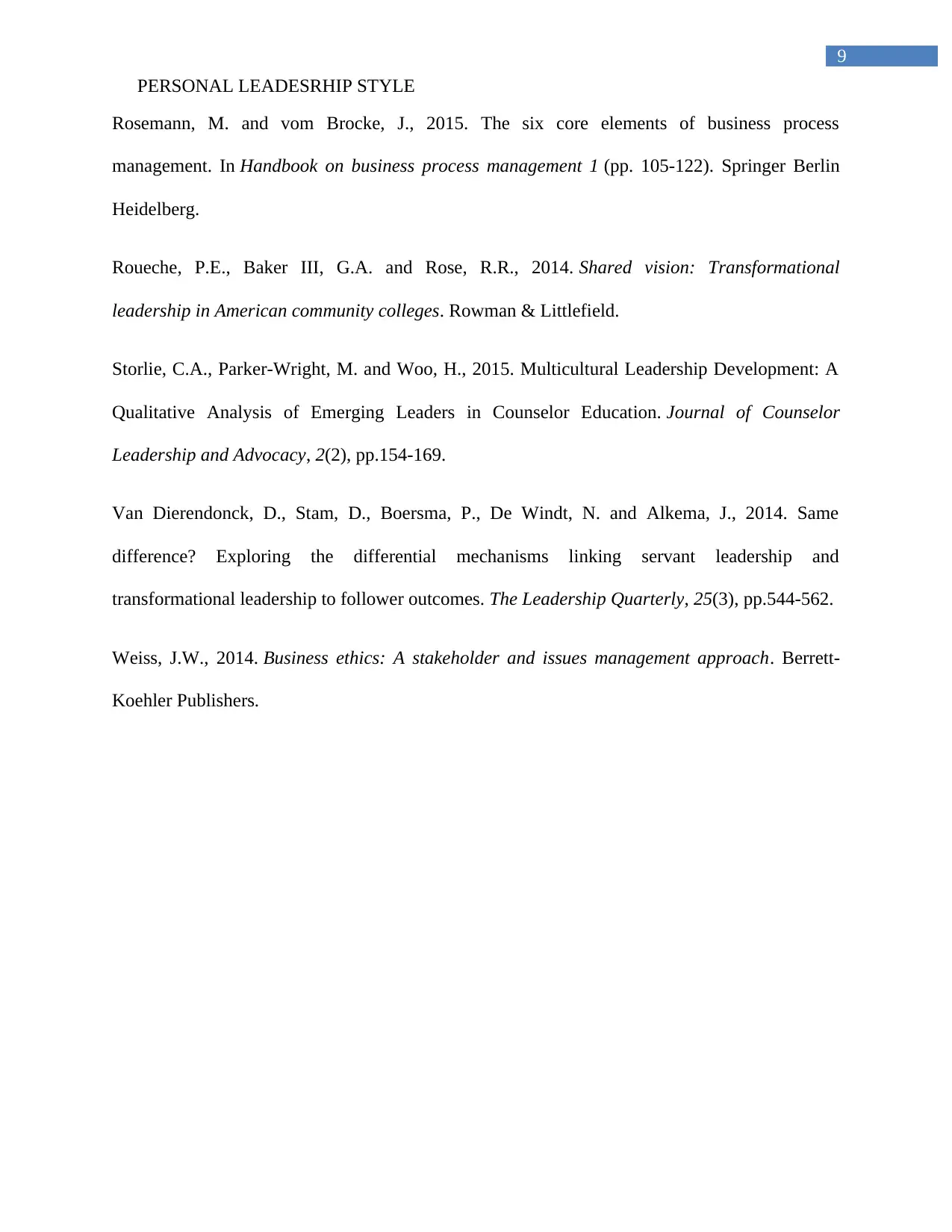
9
PERSONAL LEADESRHIP STYLE
Rosemann, M. and vom Brocke, J., 2015. The six core elements of business process
management. In Handbook on business process management 1 (pp. 105-122). Springer Berlin
Heidelberg.
Roueche, P.E., Baker III, G.A. and Rose, R.R., 2014. Shared vision: Transformational
leadership in American community colleges. Rowman & Littlefield.
Storlie, C.A., Parker-Wright, M. and Woo, H., 2015. Multicultural Leadership Development: A
Qualitative Analysis of Emerging Leaders in Counselor Education. Journal of Counselor
Leadership and Advocacy, 2(2), pp.154-169.
Van Dierendonck, D., Stam, D., Boersma, P., De Windt, N. and Alkema, J., 2014. Same
difference? Exploring the differential mechanisms linking servant leadership and
transformational leadership to follower outcomes. The Leadership Quarterly, 25(3), pp.544-562.
Weiss, J.W., 2014. Business ethics: A stakeholder and issues management approach. Berrett-
Koehler Publishers.
PERSONAL LEADESRHIP STYLE
Rosemann, M. and vom Brocke, J., 2015. The six core elements of business process
management. In Handbook on business process management 1 (pp. 105-122). Springer Berlin
Heidelberg.
Roueche, P.E., Baker III, G.A. and Rose, R.R., 2014. Shared vision: Transformational
leadership in American community colleges. Rowman & Littlefield.
Storlie, C.A., Parker-Wright, M. and Woo, H., 2015. Multicultural Leadership Development: A
Qualitative Analysis of Emerging Leaders in Counselor Education. Journal of Counselor
Leadership and Advocacy, 2(2), pp.154-169.
Van Dierendonck, D., Stam, D., Boersma, P., De Windt, N. and Alkema, J., 2014. Same
difference? Exploring the differential mechanisms linking servant leadership and
transformational leadership to follower outcomes. The Leadership Quarterly, 25(3), pp.544-562.
Weiss, J.W., 2014. Business ethics: A stakeholder and issues management approach. Berrett-
Koehler Publishers.
1 out of 10
Related Documents
Your All-in-One AI-Powered Toolkit for Academic Success.
+13062052269
info@desklib.com
Available 24*7 on WhatsApp / Email
![[object Object]](/_next/static/media/star-bottom.7253800d.svg)
Unlock your academic potential
Copyright © 2020–2025 A2Z Services. All Rights Reserved. Developed and managed by ZUCOL.




